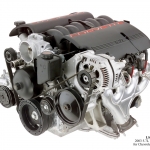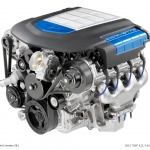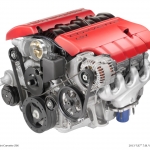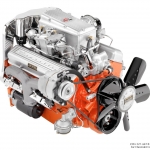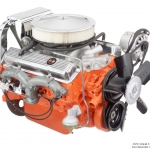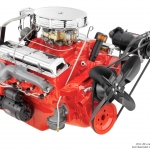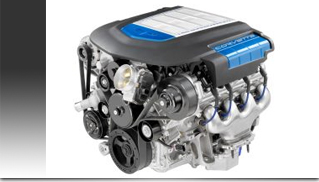 For 58 of its 60 years, the Chevrolet Corvette has been powered by the legendary Chevrolet V-8 engine. Technological advancements have increased output threefold – from 195 hp in 1955 to 638 hp today – as well as reliability, refinement and efficiency.
For 58 of its 60 years, the Chevrolet Corvette has been powered by the legendary Chevrolet V-8 engine. Technological advancements have increased output threefold – from 195 hp in 1955 to 638 hp today – as well as reliability, refinement and efficiency.
However, the fundamental architecture of the Chevrolet “Small Block” remains the same today as it was in 1955: a 90-degree V-8, with overhead valves actuated by pushrods, and a 4.4-inch on-center bore spacing.
“The brilliance of the Chevrolet V-8 is its elegant, efficient design,” said Jordan Lee, global chief engineer for Small Block Engines. “The Chevy V-8 has fewer reciprocating parts, and is very efficient and has one of the best power-to-weight ratios of any engine family in the industry. The design is incredibly compact, enabling the Corvette’s signature sleek profile and low hood line.”
Despite a sporty appearance, the early Corvettes’ performance didn’t match their good looks. The car launched in 1953 with the “Blue Flame” inline six-cylinder engine and a two-speed automatic transmission – not exactly the stuff on which to build a sports car legend. That changed in 1955, when the new small-block V-8 engine became available and was ordered by 99 percent of Corvette buyers. Read more!
Not only did the new and significantly more powerful engine breathe new life into the Corvette’s driving experience, it could be linked to a three-speed manual transmission that gave the driver an even greater connection to the car. The result made the Corvette a proper sports car, and enthusiasts responded. Sales nearly doubled from 1954 and by the end of the decade, they nearly tripled.
Immediately after the V-8 was introduced, the small-block began a steady march upward in displacement, power and technological advancement.
The Corvette’s first 4.3L (265 cu. in.) small-block engine in 1955 produced up to 195 hp with an optional four-barrel carburetor. Today, the LS9 6.2L (376 cu. in.) supercharged small-block in the Corvette ZR1 is rated at 638 hp (476 kW), delivering about 230 percent more power than the original small-block engine from only 42 percent greater displacement.
Today’s small-block is also remarkably fuel efficient. For example, the 430-horsepower (476 kW) LS3 version of the Gen-IV small-block helps the 2013 Corvette accelerate from 0 to 60 mph in about four seconds, run the quarter-mile in just more than 12 seconds and achieve a top speed of 190 mph – all while achieving EPA-estimated highway fuel economy of 26 mpg.
That fuel economy compares favorably to vehicles more commonly associated with daycare drop-off vehicles than road-course lap times. Indeed, the Corvette’s highway fuel economy is better than the 2013 Hyundai Equus (23 mpg), Volvo XC90 AWD (23 mpg) or Subaru Legacy with the 3.6L flat-6 (25 mpg) – and it matches the Toyota Venza (26 mpg). It also matches or beats other sports cars with smaller engines, including the Nissan 370Z (26 mpg/3.7L V-6), Porsche 911 Turbo (24 mpg/3.8L flat-6) and BMW Z4 (26 mpg/3.0L straight-6).
Here is a look as some of the most significant small-block engines in Corvette’s history:
1957 283 “Fuelie” – Almost 30 years before the widespread adoption of fuel injection, the Corvette offered it on the newly enlarged 283-cubic-inch small-block, resulting in 283 horsepower – and the one-horsepower-per-cubic-inch benchmark that is still considered a noteworthy performance achievement for modern engines.
1969 350 – The small-block’s displacement grew throughout the Fifties and Sixties, but when it settled at the 350-cubic-inch mark in 1969, an icon was born. Many enthusiasts equate the small-block with the classic 350, which remained the Corvette’s standard engine through 1996.
1985 “L98” Tuned Port Injection – Although electronically controlled fuel injection was introduced on the Corvette in 1981 (the early “Fuelie” engine featured mechanical fuel injection), it was the 1985 introduction of the L98-code engine and its Tuned Port Injection system that launched the modern era of performance. Its basic port-injection design is used on the 2013 Corvette and almost every other gas-powered vehicle sold in America.
1997 LS1 – The third generation of the small-block debuted in the C5 Corvette. Completely redesigned, it introduced a new aluminum “deep skirt” cylinder block, high-flow aluminum cylinder heads and more – all while retaining the basic 4.4-inch bore-center design of the original small block.
2006 LS7 – Co-developed with the C6.R racing program, it is the highest-performance naturally aspirated production small-block in Corvette history, rated at 505 hp, with a 7,000-rpm redline. It was introduced in the C6 Corvette Z06 and is also included with the 2013 427 Convertible Collector Edition. It is hand-built at GM’s Performance Build Center near Detroit.
2009 LS9 Supercharged – It’s the most powerful automotive production engine ever from Chevrolet and its 638 supercharged horses help push the Corvette ZR1 to a top speed of 205 mph. Like the LS7 engine, it is built by hand at the Performance Build Center.
